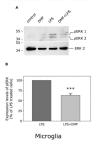Dimethylfumarate inhibits microglial and astrocytic inflammation by suppressing the synthesis of nitric oxide, IL-1beta, TNF-alpha and IL-6 in an in-vitro model of brain inflammation
- PMID: 20482831
- PMCID: PMC2880998
- DOI: 10.1186/1742-2094-7-30
Dimethylfumarate inhibits microglial and astrocytic inflammation by suppressing the synthesis of nitric oxide, IL-1beta, TNF-alpha and IL-6 in an in-vitro model of brain inflammation
Abstract
Background: Brain inflammation plays a central role in multiple sclerosis (MS). Dimethylfumarate (DMF), the main ingredient of an oral formulation of fumaric acid esters with proven therapeutic efficacy in psoriasis, has recently been found to ameliorate the course of relapsing-remitting MS. Glial cells are the effector cells of neuroinflammation; however, little is known of the effect of DMF on microglia and astrocytes. The purpose of this study was to use an established in vitro model of brain inflammation to determine if DMF modulates the release of neurotoxic molecules from microglia and astrocytes, thus inhibiting glial inflammation.
Methods: Primary microglial and astrocytic cell cultures were prepared from cerebral cortices of neonatal rats. The control cells were treated with LPS, an accepted inducer of pro-inflammatory properties in glial cells, and the experimental groups with LPS and DMF in different concentrations. After stimulation/incubation, the generation of nitric oxide (NO) in the cell culture supernatants was determined by measuring nitrite accumulation in the medium using Griess reagent. After 6 hours of treatment RT-PCR was used to determine transcription levels of iNOS, IL-1beta, IL-6 and TNF-alpha mRNA in microglial and astrocytic cell cultures initially treated with DMF, followed after 30 min by LPS treatment. Moreover, we investigated possible involvement of the ERK and Nrf-2 transduction pathway in microglia using western blot analysis.
Results: Pretreatment with DMF decreased synthesis of the proinflammatory mediators iNOS, TNF-alpha, IL-1beta and IL-6 at the RNA level in activated microglia and astrocytes in vitro, associated with a decrease in ERK phosphorylation in microglia.
Conclusions: Collectively, these results suggest that the neuroprotective effects of DMF may be in part functionally attributable to the compound's ability to inhibit expression of multiple neuroinflammatory mediators in brain of MS patients.
Figures




References
-
- Altmeyer PJ, Matthes U, Pawlak F, Hoffmann K, Frosch PJ, Ruppert P, Wassilew SW, Horn T, Kreysel HW, Lutz G, Barth J, Rietzschel I, Joshi RK. Antipsoriatic effect of fumaric acid derivatives. Results of a multicenter double-blind study in 100 patients. J Am Acad Dermatol. 1994;30:977–981. doi: 10.1016/S0190-9622(94)70121-0. - DOI - PubMed
Publication types
MeSH terms
Substances
LinkOut - more resources
Full Text Sources
Other Literature Sources
Miscellaneous

